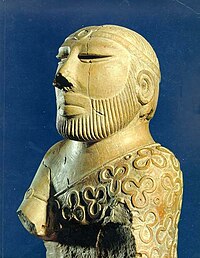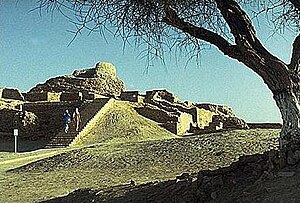 Remains of Mohejo-daro
Remains of Mohejo-daro
 "The Dancing girl" artifact found in Mohenjo-daro
"The Dancing girl" artifact found in Mohenjo-daro
 The bust of the king priest dating 2,500-1,500 BC excavated at the site of the ancient town of Mohenjo-daro.
The bust of the king priest dating 2,500-1,500 BC excavated at the site of the ancient town of Mohenjo-daro.
Mohenjo-daro
(
Sindhi
:
???? ?? ???
;
Urdu
:
???? ?????
) is an ancient
city
in
Pakistan
. It was built around 2500 BCE and was the biggest town in the ancient
Indus Valley civilization
. It's one of the earliest big cities in the world, like the ones in Egypt, Mesopotamia, Crete, and Norte Chico. People also call it the 'Mound of the Dead Men'.
[1]
It is in province of
Sindh
,
Pakistan
. The city was built around 2600
BC
. It was one of the early
urban
settlements in the world. Mohenjo-daro existed at the same time as the civilization of ancient
Egypt
,
Mesopotamia
and
Greece
. The
archaeological ruins
of the city are designated a
UNESCO
World Heritage Site. In Pakistan, it is one of the national icons of the distant past.
[2]
Mohenjo-daro was built in the 26th century BC.
[3]
It was one of the largest cities of the ancient Indus Valley Civilization,
[4]
which developed around 3000 BC from the prehistoric Indus culture. At its height, the Indus Civilization spanned much of what is now Pakistan and some parts of northwest
India
. It also had an outpost in
Bactria
. There were major urban centers at
Harappa
, Mohenjo-daro.
Mohenjo-daro was the most advanced city of its time, with remarkably sophisticated
civil engineering
and urban
planning
.
[5]
When the Indus civilization went into sudden decline around 1900 BC, Mohenjo-daro was abandoned.
[3]
[6]
The Dancing girl found in Mohenjo-daro is an artifact that is some 4500 years old. The 10.8 cm long bronze statue of the dancing girl was found in 1926 from a house in Mohenjo-daro. She was British archaeologist Mortimer Wheeler's favorite statuette, as he said in this quote from a 1973 television program:
- "There is her... pouting lips and insolent look in the eyes. She's about fifteen years old I should think, not more, but she stands there with bangles all the way up her arm and nothing else on. A girl perfectly, for the moment, perfectly confident of herself and the world. There's nothing like her, I think, in the world".
John Marshall, one of the excavators at Mohenjo-daro, described her as a vivid impression of the young ...
girl, her hand on her hip in a half-impudent posture, and legs slightly forward as she beats time to the music with her legs and feet.
[7]
A seated male
sculpture
is the so-called "Priest King" (even though there is no evidence that either
priests
or
kings
ruled the city). Archaeologists discovered the sculpture in Lower town at Mohenjo-daro in 1927. It was found in an unusual house with ornamental brickwork and a wall niche and was lying between brick foundation walls which once held up a floor.
This bearded sculpture wears a fillet around the head, an armband, and a cloak decorated with trefoil patterns that were originally filled with red pigment.
 Surviving structures at Mohenjo-daro.
Surviving structures at Mohenjo-daro.
- ↑
Centre, UNESCO World Heritage.
"Archaeological Ruins at Moenjodaro"
.
UNESCO World Heritage Centre
.
- ↑
Aitzaz Ahsan 1997.
Indus saga and the making of Pakistan
Karachi: Oxford University Press.
- ↑
3.0
3.1
Ancientindia.co.uk.
Retrieved 2012-05-02.
- ↑
Beck, Roger B.
et al
1999 (1999).
World History: patterns of interaction
. Evanston, IL: McDougal Littell.
ISBN
0-395-87274-X
.
{{
cite book
}}
: CS1 maint: numeric names: authors list (
link
)
- ↑
Dani A.H. 1992. Critical assessment of recent evidence on Mohenjo-daro.
Second International Symposium on Mohenjo-daro
, 24?27 February 1992.
- ↑
Kenoyer, Jonathan Mark 1998. Indus cities, towns and villages.
Ancient Cities of the Indus Valley Civilization
. Islamabad: American Institute of Pakistan Studies. p.65
- ↑
Possehl, Gregory (2002).
The Indus Civilization: a contemporary perspective
. AltaMira Press. pp.
113
.
ISBN
978-0759101722
.